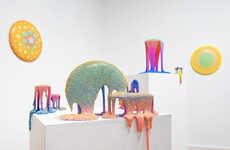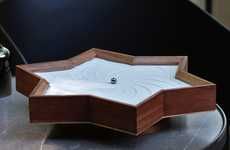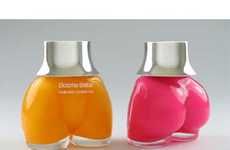
Sachiko Kodama Shows That Material Science Has An Artsy Side
Katie Cordrey — July 15, 2009 — Art & Design
References: kodama.hc.uec.ac.jp & physicscentral
Sachiko Kodama uses ferrofluids to make amazing art.
Ferrofluids are made up of surfactant-coated magnetic nanoparticles suspended in a carrier fluid. The substance flows like a liquid and attracts to a magnet. It has a wide and increasing array of scientific and industrial applications, but Kodama is recognized for her out of the box thinking about the substance and her beautiful, sculptural art.
The Japanese artist combined her love of art and science in exploring the fascinating material and applied her training in art, design, physics, and holography to create fantastic sculptural expressions using ferrofluid.
Though the video above is a couple of years old, it is an inspiring overview of the material and the artist.
Ferrofluids are made up of surfactant-coated magnetic nanoparticles suspended in a carrier fluid. The substance flows like a liquid and attracts to a magnet. It has a wide and increasing array of scientific and industrial applications, but Kodama is recognized for her out of the box thinking about the substance and her beautiful, sculptural art.
The Japanese artist combined her love of art and science in exploring the fascinating material and applied her training in art, design, physics, and holography to create fantastic sculptural expressions using ferrofluid.
Though the video above is a couple of years old, it is an inspiring overview of the material and the artist.
Trend Themes
1. Artistic Applications of Ferrofluids - Exploring the creative possibilities of ferrofluids in art opens up new avenues for artistic expression and collaboration.
2. Integration of Science and Art - The convergence of art and science presents opportunities for interdisciplinary collaborations and the creation of unique, visually stunning experiences.
3. Advancements in Ferrofluid Technology - Continued research and development in ferrofluid technology could lead to innovative applications across various fields, from medicine to engineering.
Industry Implications
1. Art and Design - Artists and designers can leverage ferrofluids to push the boundaries of traditional art forms and create captivating visual experiences.
2. Science and Technology - Scientists and engineers can explore the potential of ferrofluids in fields like robotics, fluid dynamics, and materials science to discover new solutions and advancements.
3. Entertainment and Events - The incorporation of ferrofluids in live performances, interactive installations, and exhibitions can captivate audiences and provide unique sensory experiences.
4.3
Score
Popularity
Activity
Freshness















